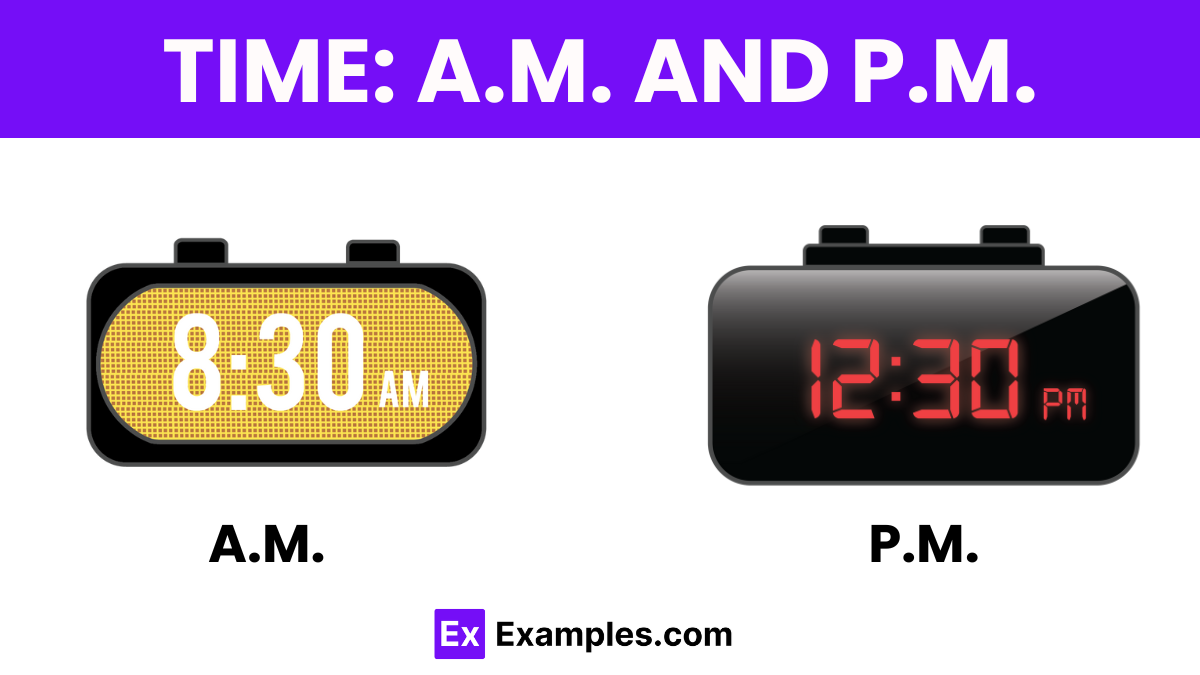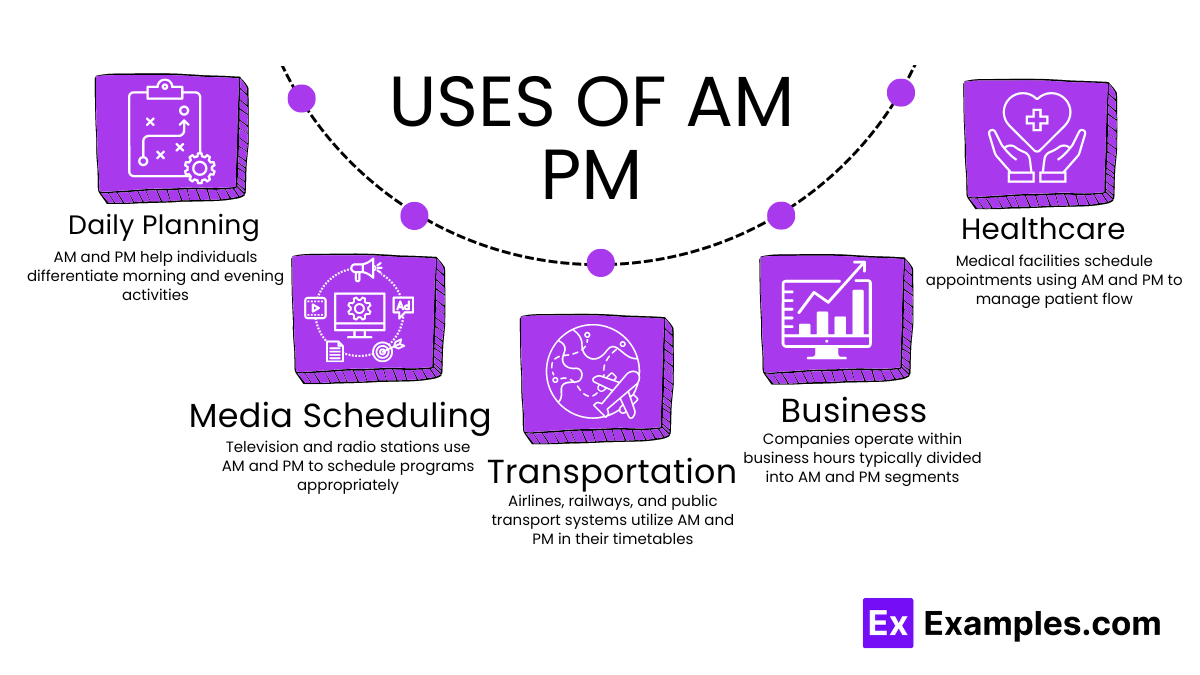What time is 2:30 PM in 24-hour format?
12:30
14:30
16:30
18:30


AM and PM are abbreviations used to distinguish the two 12-hour blocks in a day in the 12-hour clock system. AM stands for “Ante Meridiem,” meaning “before midday,” and covers the hours from midnight to noon. Conversely, PM stands for “Post Meridiem,” meaning “after midday,” and spans the hours from noon to midnight. Consequently, these terms help people manage their schedules and activities by clearly separating the day into morning and afternoon/evening segments.
AM, or “Ante Meridiem,” translates to “before midday” and includes the hours from midnight to noon. Meanwhile, PM, or “Post Meridiem,” means “after midday” and encompasses the hours from noon to midnight. These terms are crucial for daily planning, as they clearly delineate the morning from the afternoon and evening, aiding in time management and the scheduling of events. Furthermore, understanding these terms ensures clarity in communication about time, especially in contexts where precise timing is essential.

Various tools are utilized to distinguish between AM and PM, aiding in daily time management and planning.
AM and PM are abbreviations used in the 12-hour clock system to denote the two halves of a day. AM stands for “Ante Meridiem,” which is Latin for “before midday.” This term covers the hours from midnight to noon. On the other hand, PM stands for “Post Meridiem,” translating to “after midday,” and it includes the hours from noon to midnight.
These designations are crucial for daily activities as they help differentiate morning times from afternoon and evening times. Furthermore, the use of AM and PM facilitates clear communication about meeting times, event schedules, and public transportation timings, ensuring that activities are planned accurately and efficiently throughout the day.

Time divisions of A.M. and P.M. play essential roles in structuring our daily schedules. A.M., which stands for “Ante Meridiem,” indicates the hours from midnight to noon. This period helps individuals plan morning routines and early day activities. Conversely, P.M., standing for “Post Meridiem,” marks the hours from noon to midnight, covering afternoon and evening schedules.
These notations ensure that we can organize and differentiate events accurately within the 12-hour clock system. Moreover, they assist in coordinating global communications and travel plans, where clarity in time-telling is crucial. By using A.M. and P.M., we effectively manage our daily commitments, ensuring a smooth transition from work to leisure activities as the day progresses.
The 12-hour clock divides the 24-hour day into two periods of 12 hours each. This system uses the abbreviations A.M. (Ante Meridiem) for the hours from midnight to noon and P.M. (Post Meridiem) for the hours from noon to midnight.
This format simplifies time-telling by breaking the day into manageable segments, making it easier for people to plan their daily activities. Additionally, the 12-hour clock is widely used in several countries, particularly in everyday applications such as clocks, broadcasts, and scheduling, enhancing its practicality.
Furthermore, by distinguishing clearly between morning and afternoon, the 12-hour clock helps avoid confusion in daily communication and scheduling. It plays a pivotal role in schools, workplaces, and social arrangements, ensuring that the timing of events is understood universally among those who use this system.
The 24-hour clock system represents time without repeating hours during the day, distinguishing each hour by a unique number from 00 to 23. This method starts at midnight, labeled as 00:00, and ends at 23:59 just before the next midnight.
This format significantly reduces confusion in scheduling, especially in sectors like military, aviation, and international business, where precise communication is crucial. Additionally, the 24-hour clock is favored in many parts of the world for its clarity and efficiency in timekeeping.
Moreover, the 24-hour format simplifies time conversion and calculation, as it avoids the need for AM and PM distinctions. This system is particularly useful for programming and logistical planning, ensuring clear and unambiguous time reporting around the clock.
Here’s a table illustrating the time segmentation of a day into AM and PM periods in the 12-hour clock format:
| Time Segment | Description | Starts at | Ends at |
|---|---|---|---|
| AM (Ante Meridiem) | Before midday, covers morning hours | 12:00 AM | 11:59 AM |
| PM (Post Meridiem) | After midday, covers afternoon and evening hours | 12:00 PM | 11:59 PM |
This format helps clarify daily schedules by dividing the 24-hour day into two distinct halves, ensuring effective planning and time management within a familiar framework.
Understanding how to differentiate between AM and PM is essential when dealing with time management and scheduling in the 12-hour clock system. Here’s a straightforward guide to understanding and using AM and PM in daily life:
AM signifies the time from midnight to just before noon. It is used to schedule morning activities and appointments.
Example: If you set an alarm for 7:00 AM, it will ring in the morning.
PM denotes the time from noon to just before midnight. It is used for scheduling afternoon and evening events.
Example: A meeting scheduled at 3:00 PM takes place in the afternoon.
Noon marks the shift from AM to PM. Understanding this transition is crucial for planning activities that span across the middle of the day.
Example: Lunch at 12:00 PM marks the beginning of the PM period.
Midnight is the time when PM ends and AM begins, resetting the cycle for the new day.
Example: New Year celebrations typically start before midnight (PM) and continue into the early hours (AM).
Converting from the 12-hour AM/PM clock system to the 24-hour clock, commonly used in military, aviation, and much of the world, is straightforward. This format avoids confusion by eliminating the need for AM and PM designations. Here’s how the conversion process works, presented in an easy-to-follow table format:
| 12-Hour Clock (AM/PM) | 24-Hour Clock |
|---|---|
| 12:00 AM | 00:00 |
| 1:00 AM | 01:00 |
| 2:00 AM | 02:00 |
| 3:00 AM | 03:00 |
| 4:00 AM | 04:00 |
| 5:00 AM | 05:00 |
| 6:00 AM | 06:00 |
| 7:00 AM | 07:00 |
| 8:00 AM | 08:00 |
| 9:00 AM | 09:00 |
| 10:00 AM | 10:00 |
| 11:00 AM | 11:00 |
| 12:00 PM | 12:00 |
| 1:00 PM | 13:00 |
| 2:00 PM | 14:00 |
| 3:00 PM | 15:00 |
| 4:00 PM | 16:00 |
| 5:00 PM | 17:00 |
| 6:00 PM | 18:00 |
| 7:00 PM | 19:00 |
| 8:00 PM | 20:00 |
| 9:00 PM | 21:00 |
| 10:00 PM | 22:00 |
| 11:00 PM | 23:00 |
This table helps clarify the direct correspondence between the two time-keeping systems, aiding in the transition from AM/PM to a 24-hour format. Such conversions are particularly useful for scheduling across different regions and cultures that utilize different time-keeping standards.
Converting from the 24-hour clock, which is standard in military and international contexts, to the 12-hour AM/PM clock used primarily in the U.S. and a few other regions is simple and useful for everyday activities. This table illustrates the conversion process clearly:
| 24-Hour Clock | 12-Hour Clock (AM/PM) |
|---|---|
| 00:00 | 12:00 AM |
| 01:00 | 1:00 AM |
| 02:00 | 2:00 AM |
| 03:00 | 3:00 AM |
| 04:00 | 4:00 AM |
| 05:00 | 5:00 AM |
| 06:00 | 6:00 AM |
| 07:00 | 7:00 AM |
| 08:00 | 8:00 AM |
| 09:00 | 9:00 AM |
| 10:00 | 10:00 AM |
| 11:00 | 11:00 AM |
| 12:00 | 12:00 PM |
| 13:00 | 1:00 PM |
| 14:00 | 2:00 PM |
| 15:00 | 3:00 PM |
| 16:00 | 4:00 PM |
| 17:00 | 5:00 PM |
| 18:00 | 6:00 PM |
| 19:00 | 7:00 PM |
| 20:00 | 8:00 PM |
| 21:00 | 9:00 PM |
| 22:00 | 10:00 PM |
| 23:00 | 11:00 PM |
This conversion table facilitates easy translation between the two systems, enhancing understanding for those accustomed to the AM/PM format. It is particularly helpful in personal scheduling, media programming, and any scenario where clear communication of time is essential.
Remembering the full forms of AM and PM can be simplified with mnemonic devices and understanding their Latin origins. Here are some tips:

Midnight, occurring at 12:00 AM, signifies the onset of a new day. It marks the transition from the ending of one day to the beginning of the next, serving as a critical reset point for daily activities and systems. Noon, identified as 12:00 PM, represents the midpoint of the day, effectively dividing the morning hours from the afternoon. It plays a crucial role in daily time management, often used as a standard moment for breaks and as a synchronization point for various schedules. Together, midnight and noon are essential in structuring and organizing our daily routines, from personal planning to professional engagements.
Midnight refers to 12:00 AM, which signifies the start of a new day. It marks the transition from one day to the next and is considered the middle of the night. This is a crucial time for resetting many daily cycles, such as the calendar date and often, digital systems that rely on a daily reset.
Noon, on the other hand, is 12:00 PM. This time represents the middle of the daytime hours, dividing the morning from the afternoon. Noon is significant for timekeeping purposes, especially for determining the culmination of the AM hours and the beginning of the PM hours. It is often used as a standard reference point for coordinating activities and is a common break time in many cultures.
Together, midnight and noon serve as key reference points for organizing daily life, helping to structure everything from work schedules to broadcasting timelines. Their roles are integral in managing the continuous flow of hours and activities each day.

AM and PM are essential for organizing daily activities and maintaining schedules across various contexts:
Fill in the Blanks: Examples for AM and PM
Answers:
To calculate AM and PM, divide the day into two 12-hour segments. Hours from midnight to noon are labeled as AM, while noon to midnight are labeled as PM.
12:00 at midday is labeled as PM, indicating the start of the afternoon period. Conversely, 12:00 at midnight is considered AM, marking the beginning of the day.
AM represents the morning hours in the 12-hour clock system, spanning from midnight to just before noon. This period includes the early and late morning times.
Text prompt
Add Tone
10 Examples of Public speaking
20 Examples of Gas lighting
What time is 2:30 PM in 24-hour format?
12:30
14:30
16:30
18:30
Which time is in the morning?
1:00 PM
3:00 PM
7:00 AM
9:00 PM
What time is 23:45 in 12-hour format?
11:45 AM
11:45 PM
12:45 PM
12:45 AM
What is the correct representation of midnight in 12-hour format?
12:00 AM
12:00 PM
00:00 AM
00:00 PM
If the time is 6:15 AM, what is it in 24-hour format?
06:15
16:15
18:15
06:45
Which time is in the afternoon?
10:00 AM
12:00 PM
4:00 PM
8:00 AM
What time is 15:30 in 12-hour format?
3:30 AM
3:30 PM
5:30 AM
5:30 PM
Which of the following is a nighttime time?
10:00 AM
2:00 PM
8:00 PM
6:00 AM
What is the correct representation of noon in 24-hour format?
12:00
00:00
24:00
12:00 AM
If the time is 10:45 PM, what is it in 24-hour format?
20:45
21:45
22:45
23:45
Before you leave, take our quick quiz to enhance your learning!

